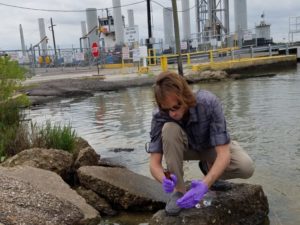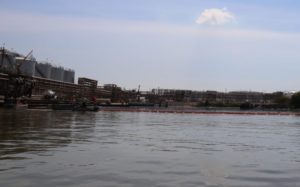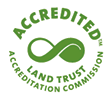Environmental Impacts of ITC Fire: What Galveston Bay Foundation Has Found
- January 14, 2020
- News
TAMU Presentation on PFAs Collaboration & Results

Galveston Bay Foundation Water Monitoring on March 23, 2019.
After the ITC chemical tank fire, Galveston Bay Foundation partnered with Texas A&M’s Superfund Research Center to analyze water samples around the ITC incident for PFAs, a group of chemical compounds frequently found in industrial product and firefighting foam. Some of these compounds are known to have harmful health impacts, but the extent of harm is still widely unknown. They are water soluble, persistent in the environment, and accumulate in both the water column and the wildlife. Overall, the results show a definite presence of many different PFAs in the water of the Houston Ship Channel. Highest levels were found near ITC, but even the samples that were taken from the shoreline further downstream showed levels of concern. In addition to the detected PFAs with established health advisory levels, other PFA compounds that have yet to be evaluated for their potential effects on human health and wildlife were also detected. Additionally, some locations saw an increase in PFAs levels from March 21st to March 29th. Unfortunately, regular monitoring of these compounds has not historically occurred in Galveston Bay, so there is little to no pre-incident data for comparison to understand what impact the ITC incident may have had on the levels of PFAs in the water. Galveston Bay Foundation continued to collect samples for ongoing analysis through summer 2019. This data has been shared with agencies responsible for natural resource damage assessment around the ITC incident.
ITC Chemical Tank Fire Water Sample Response Timeline
March / Summary: In an effort to track potential environmental impacts from the ITC fires and resultant cleanup, Galveston Bay Foundation collected and analyzed water samples on Friday, March 22 and Saturday, March 23. These samples were tested for benzene, toluene, ethylbenzene, and xylenes. These compounds are frequently found in petrochemical biproducts and can pose threats to human health.
Galveston Bay Foundation collected five water samples from the Houston Ship Channel on Friday and six samples from nearby shoreline locations on Saturday. Friday’s samples were collected just prior to the ITC berm failure and subsequent reignition of the fire. Samples showed slightly elevated benzene levels right at the ITC facility in relation to other samples. However, all samples from Friday yielded results below state standards and federal guidelines.
To better document the impacts of the berm failure and fire, Galveston Bay Foundation collected six additional samples on Saturday, March 23rd. As the Ship Channel was closed due to impaired air quality, samples were collected from nearby nearshore locations. One sample (sample 7) from Saturday collected near the Lynchburg Ferry yielded elevated levels of benzene at 46 µg/L. This is above EPA’s recommended National Ambient Water Quality Criteria of 16 µg/L but below TCEQ’s state standards. All other samples collected Saturday had concentrations below state standards and national criteria.
April 24th: Galveston Bay Foundation has continued monitoring for VOCs and PFAs, most recently testing on April 24, 2019. These samples were taken in the immediate vicinity of the ITC incident.
April 11th: Galveston Bay Foundation sampled all six shoreline locations for VOCs and PFAs on April 11, 2019. All VOCs were below detection levels for compounds listed on this map. These PFAs samples have been sent to Texas A&M for processing.
April 5th: Galveston Bay Foundation sampled all six shoreline locations for VOCs on April 5, 2019. All samples were below detection levels for compounds listed on this map. Galveston Bay Foundation is still waiting to receive information on PFAs concentrations from our partners at Texas A&M.
Galveston Bay Foundation will continue to collect samples from the shoreline on Friday, April 11th. Galveston Bay Foundation will collect samples for both VOCs and PFAs.
This map shows all locations where Galveston Bay Foundation collected samples, as well as the results for each sample. Click on each location to view the results from the site. “No data” means that for that sample, data analysis did not meet the fit quality criterion for this analyte or the reported concentration for the analyte is below the quantitation limit. These samples were analyzed in partnership with Environmental Defense Fund.
Additional Information
TCEQ Standards for Galveston Bay waters(waters not used as a source of drinking water)
The state standards for each compound are highlighted below.
| Compound | TCEQ Standard (µg/L) |
| Benzene | 581 µg/L |
| Toluene | — |
| Ethylbenzene | 1,867 µg/L |
| Xylenes | No standards listed at all |
More information on these standards can be found at: https://www.tceq.texas.gov/waterquality/standards/2018-surface-water-quality-standards#sixthAnchor
Below is some relevant information related to these standards, quoted from the TCEQ 2018 guidelines linked above:
(2) Categories of human health criteria (pgs 40-41):
(B) concentration criteria to prevent contamination of fish and other aquatic life to ensure that they are safe for human consumption. These criteria apply to surface waters that have sustainable fisheries and that are not designated or used for public water supply or as a sole-source surface drinking water supply (Column B in Table 2 of paragraph (1) of this subsection);
(B) For known or suspected carcinogens (as identified in EPA’s IRIS database), an incremental cancer risk level of 10-5 (1 in 100,000) was used to derive criteria. An RfD (reference dose) was determined for carcinogens and noncarcinogens where the EPA has not derived cancer slope factors.
(C) Consumption rates of fish and shellfish were estimated as 17.5 grams per person per day, unless otherwise specified in Table 2 of paragraph (1) of this subsection.
(E) For carcinogens, a body-weight scaling factor of 3/4 power was used to convert data on laboratory test animals to human scale. Reported weights of laboratory test animals are used, and an average weight of 70 kilograms is assumed for humans.”
…….
“(7) Specific human health criteria are applied as long-term average exposure criteria designed to protect populations over a lifetime. Attainment measures for human health are addressed in §307.9 of this title. Pg. 43
EPA National Ambient Water Quality Criteria (waters not used as a source of drinking water)
| Compound | TCEQ Standard (µg/L) |
| Benzene | 16-58 µg/L |
| Toluene | 520 µg/L |
| Ethylbenzene | 130 µg/L |
| Xylenes | No standards listed at all |
The national Ambient Water Quality Criteria for each compound are highlighted in the table below. These criteria are meant to guide states when establishing their regulatory standards for each contaminant. For human health, these levels are calculated at cancer rates of one in 1,000,000 people exposed.
More information on these Criteria can be found at: https://www.epa.gov/wqc/national-recommended-water-quality-criteria-human-health-criteria-table

Outside the ITC plant on Friday, March 22, 2019
If you have questions, please call us at 281-332-3381 or email info@galvbay.org.




